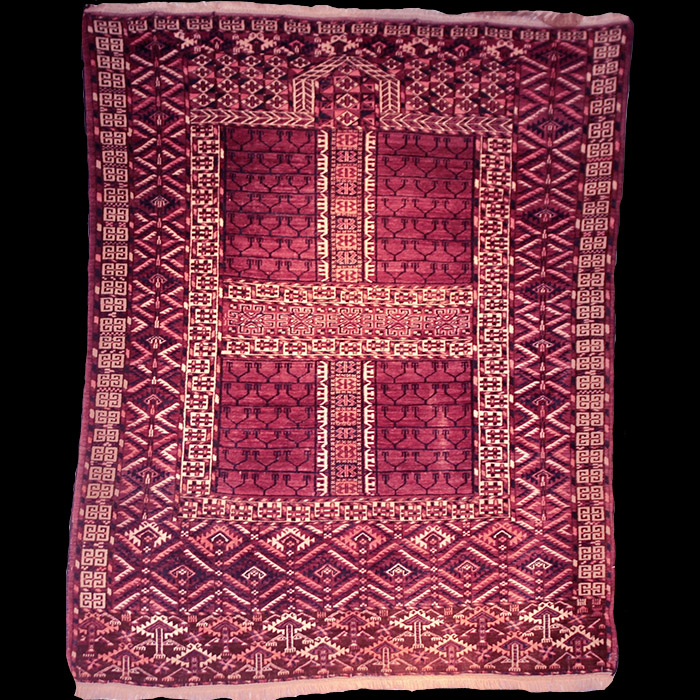Clay Stewart Collection of Türkmen Textiles
14. Ahal Teke Türkmen Ensi Hatchli (inner door-entrance covering)
Ca. 1875. Size: 73 ft. 9 in. x 4 ft. 7in.
Ca. 1875. Size: 73 ft. 9 in. x 4 ft. 7in.

Lustrous pinning wheel processed wool in foundation, all vegetable dyes. 10 x 20 asymmetrical knots pulled open to the right resulting in width/height ratio of 1:2. Knots flat (symmetrical, an Ahal feature Moshkova) from the back and blonde wool weft shoots invisible when viewed from the back. 4-cord side edge overcast evenly in dark blue yarn.
Use: Decorative, inner enclosure for the öÿ entrance, facing into the inside of the tent, usually felt mats covered the outside of the ensi, protecting it from the weather. The small open area underneath the ensi is filled with a gapylyk (a thing for the door) to keep out sand, cold wind, etc..
Hatchli is the old Armenian word for cross. Ensi refers to a Turkmen’s tent door enclosure. This Ensi’s center field shows a cross (pre-Christian) dividing the field into four partitions with field ornaments of ensi nagish motif (tree patterns with an inverted E motif on both branches) in each quadrant and a mihrab (prayer niche) at the center top. The center vertical bar of the cross shows a double cross gochak variant with meander (meandering vine) flanked on each side by the Bovrek (O’Bannon) motif (bow & arrow) guard borders square’s four sides with a minor guard stripe showing the Tengejik pattern and this is flanked by an unknown pattern. The center horizontal cross bar is divided into three stripes comprised of a sainak variant with hooked motifs in the center and flanked by two it tapan guard borders interlinked by a gyak boarder. Inverted E pattern amulets seen throughout the field. Two major side borders have sakar gishik (untranslated) pattern with stalks of ok gozi (uzi in Türkmen) which end the borders at the top and bottom with an aşhyk (dogdan) variant on the top border and flanking the niche border are a variant of the sichan izi pattern. The outside main border with the exception of the lower apron is sainak. Outer perimeter has single gyak stripe. Field has gochanak variant and lower apron has kelle gochanak variant. 2 vertical main side borders only, with kelle with ok gozi in the stalk variant, lower panel has animal trees with ashyk medallions, second panel has larger animal trees with ashyk again, all ashyk forms are capped with ram’s horns. The design of this rug bears a resemblance to tablets of Nestorian Monks in the 6th century who introduced Christianity to China. These tablets had the 4 quarter principle with heaven and hell above and below in a similar depiction of life as a codex.
Animal Tree Ensi.
Ahal oasis, Teke quartering area, 19th century, Turkmenistan.
Visit Glossary page for any further definitions not highighted in red in a pop-up window.